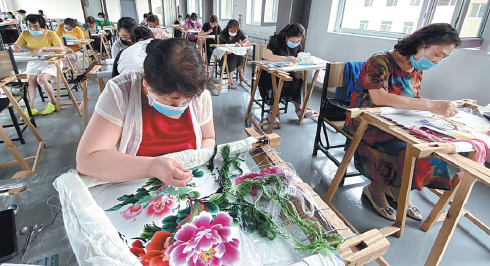Shanxi employs variety of tactics for rural revitalization
Updated: 2021-06-04

Women work at an embroidery factory in Xiyang county, Shanxi province. The traditional handicraft industry is now an important force to drive growth in rural Shanxi. [Photo by Li Zhaomin for China Daily]
Developing hallmark industries, relocating people to better areas and modernizing farming key moves
Li Fentuan, a woman in Daixian, a county of Xinzhou city in Shanxi province, now sees her embroidery work as more enjoyable.
The trade, which she has been engaged in for about two decades, has earned her a decent livelihood. The revenue helped her support a family, escape poverty and move to a new, spacious apartment in the county seat.
The county seat is about 20 kilometers from the famed Great Wall pass of Yanmen. As such, the local craft is known as Yanmen Embroidery throughout China.
It has been a historical tradition that women in Daixian are encouraged to master skills in folk crafts such as embroidery and paper-cutting. It is said such skills are related to their happiness after marriage.
But it wasn't until the late 1990s that such crafts developed into industries with local characteristics.
Gao Fenglan, a retired female official, was one of the pioneers to develop Yanmen Embroidery into a local industry.
An enthusiast and master of Yanmen Embroidery, Gao's initial goal was to protect the centuries-old intangible cultural heritage and pass it down to future generations. She did this by sharing her skills with the younger women in her neighborhood.
She later found their embroidery was so sought-after by customers that she decided to start her own business-the embroidery studio that Li Fentuan works for.
Thanks to the efforts of inheritors like Gao, Yanmen Embroidery was included on the provincial list of intangible cultural heritage in 2007.
Products made by the studio have been sold throughout the country and the world.
Gao's studio has also offered training to more than 6,000 people from Daixian and the rest of China.
Zhengxiashe village in Ekou township, where the studio is located, is among the greatest beneficiaries from the industry.
"Boosted by the embroidery industry, our village was removed from the poverty list in 2016," said Tian Zhong, Party secretary of the village.
He noted that while it offers jobs to women, the embroidery studio has held training courses and helped to sell products made by local people.
"In 2016, the embroidery industry brought per capita revenue of 80,000 yuan ($12,700) to the people involved," Tian said.
The embroidery industry in Daixian is just one example of how Shanxi has used various means to help with poverty alleviation and rural revitalization.
During a May 25 conference that summarized Shanxi's experiences in poverty reduction and promoting rural revitalization, officials said the province has achieved success over the eight years since the overall campaign for poverty reduction was launched.
They said all of Shanxi's 3.29 million impoverished people, 58 impoverished counties and 7,993 impoverished villages have been lifted from their poverty status.
The achievement was made thanks to the province's targeted poverty-reduction measures. They included developing industries with local characteristics, relocating residents to places with better living conditions and organizing vocational training, as well as improving healthcare, education and the rural living environment.
In many parts of Shanxi, local authorities have combined some of the targeted measures into a package, offering an integrated solution for poverty reduction.
In Gucheng township, Yanggao county, a huge expanse of greenhouses have been built near new settlements that host 959 relocated households.
The greenhouses, built on land rented from these households, were jointly developed by the Yanggao county government and Datong-based agricultural company Fangu Guizhen.
According to a new county policy, every household there is assigned one greenhouse, taking charge of the farming and harvesting of vegetables and fruit.
Zan Xiaoguo, 59, is one of the farmers working in the greenhouses.
"Compared with grain farming, vegetables in greenhouses can be planted and harvested throughout the year," Zan said. "It means my family can have a stable monthly income of more than 2,000 yuan."
But this is not the only source of revenue, Zan said. "We are paid land rental on an annual basis and some members of my family work at nearby factories."
There are a number of factories and plants in the neighborhood, offering a variety of jobs to residents.
"As the factories were established for the purpose of poverty reduction, residents from low-income families are a priority in their recruitment," a local official said.
As Shanxi made a success in its poverty-reduction work, it is shifting emphasis to rural revitalization.
The May 25 conference also announced the establishment of a new organization, the Shanxi Rural Revitalization Bureau, to take the place of the Shanxi Poverty Reduction Office.
"We have made historic achievements in poverty reduction. However, we will never put an end to our efforts in improving the livelihoods of people in rural Shanxi," a senior provincial official said at the conference.
He said Shanxi's plans for rural revitalization will include modernizing agriculture, developing characteristic industries, promoting rural-urban integration, protecting the environment and improving rural governance.
Xue Lin contributed to this story.



